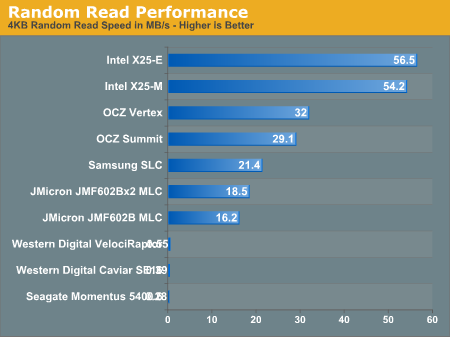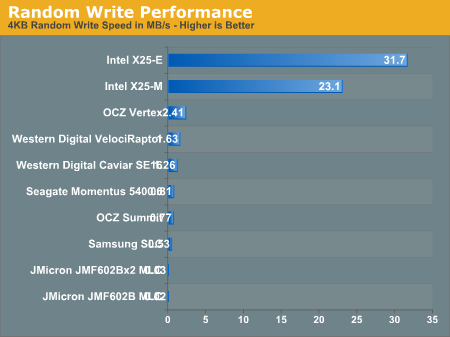The SSD Anthology: Understanding SSDs and New Drives from OCZ
by Anand Lal Shimpi on March 18, 2009 12:00 AM EST- Posted in
- Storage
Random Read/Write Performance
Arguably much more important to any PC user than sequential read/write performance is random access performance. It's not often that you're writing large files sequentially to your disk, but you do encounter tons of small file reads/writes as you use your PC.
To measure random read/write performance I created an iometer script that peppered the drive with random requests, with an IO queue depth of 3 (to add some multitasking spice to the test). The write test was performed over an 8GB range on the drive, while the read test was performed across the whole drive. I ran the test for 3 minutes.

The three hard drives all posted scores below 1MB/s and thus aren't visible on our graph above. This is where SSDs shine and no hard drive, regardless of how many you RAID together, can come close.
The two Intel drives top the charts and maintain a huge lead. The OCZ Vertex actually beats out the more expensive (and unreleased) Summit drive with a respectable 32MB/s transfer rate here. Note that the Vertex is also faster than last year's Samsung SLC drive that everyone was selling for $1000. Even the JMicron drives do just fine here.
If we look at latency instead of transfer rate it helps put things in perspective:

Read latencies for hard drives have always been measured in several ms, but every single SSD here manages to complete random reads in less than 1ms under load.
Random write speed is where we can thin the SSD flock:

Only the Intel drives and to an extent, the OCZ Vertex, post numbers visible on this scale. Let's go to a table to see everything in greater detail:
| 4KB Random Write Speed | |
| Intel X25-E | 31.7 MB/s |
| Intel X25-M | 23.1 MB/s |
| JMicron JMF602B MLC | 0.02 MB/s |
| JMicron JMF602Bx2 MLC | 0.03 MB/s |
| OCZ Summit | 0.77 MB/s |
| OCZ Vertex | 2.41 MB/s |
| Samsung SLC | 0.53 MB/s |
| Seagate Momentus 5400.6 | 0.81 MB/s |
| Western Digital Caviar SE16 | 1.26 MB/s |
| Western Digital VelociRaptor | 1.63 MB/s |
Every single drive other than the Intel X25-E, X25-M and OCZ's Vertex is slower than the 2.5" Seagate Momentus 5400.6 hard drive in this test. The Vertex, thanks to OCZ's tweaks, is now 48% faster than the VelociRaptor.
The Intel drives are of course architected for the type of performance needed on a desktop/notebook and thus they deliver very high random write performance.
Random write performance is merely one corner of the performance world. A drive needs good sequential read, sequential write, random read and random write performance. The fatal mistake is that most vendors ignore random write performance and simply try to post the best sequential read/write speeds; doing so simply produces a drive that's undesirable.
While the Vertex is slower than Intel's X25-M, it's also about half the price per GB. And note that the Vertex is still 48% faster than the VelociRaptor here, and multiple times faster in the other tests.










250 Comments
View All Comments
SkullOne - Wednesday, March 18, 2009 - link
Fantastic article. Definitely one of the best I've read in a long time. Incredibly informative. Everyone who reads this article is a little bit smarter afterwards.All the great information about SSDs aside, I think the best part though is how OCZ is willing to take blame for failure earlier and fix the problems. Companies like that are the ones who will get my money in the future especially when it is time for me to move from HDD to SSD.
Apache2009 - Wednesday, March 18, 2009 - link
i got one Vertex SSD. Why suspend will cause system halt ? My laptop is nVidia chipset and it is work fine with HDD. Somebody know it ?MarcHFR - Wednesday, March 18, 2009 - link
Hi,You wrote that there is spare-area on X25-M :
"Intel ships its X25-M with 80GB of MLC flash on it, but only 74.5GB is available to the user"
It's a mistake. 80 GB of Flash look like 74.5GB for the user because 80,000,000,000 bytes of flash is 74.5 Go for the user point of view (with 1 KB = 1024 byte).
You did'nt point out the other problem of the X25-M : LBA "optimisation". After doing a lot of I/O random write the speed in sequential write can get down to only 10 MB /s :/
Kary - Thursday, March 19, 2009 - link
The extra space would be invisible to the end user (it is used internally)Also, addressing is normally done in binary..as a result actual sizes are typically in binary in memory devices (flash, RAM...):
64gb
128gb
80 GB...not compatible with binary addressing
(though 48GB of a 128GB drive being used for this seems pretty high)
ssj4Gogeta - Wednesday, March 18, 2009 - link
Did you bother reading the article? He pointed out that you can get any SSD (NOT just Intel's) stuck into a situation when only a secure erase will help you out. The problem is not specific to Intel's SSD, and it doesn't occur during normal usage.MarcHFR - Wednesday, March 18, 2009 - link
The problem i've pointed out has nothing to do with the performance dregradation related to the write on a filled page, it's a performance degradation related to an LBA optimisation that is specific to Intel SSD.VaultDweller - Wednesday, March 18, 2009 - link
So where would Corsair's SSD fit into this mix? It uses a Samsung MLC controller... so would it be comparable to the OCZ Summit? I would expect not since the rated sequential speeds on the Corsair are tremendously lower than the Summit, but the Summit is the closest match in terms of the internals.kensiko - Wednesday, March 18, 2009 - link
No, OCZ Summit = newest Samsung controller. The Corsair use the previous controller, smaller performance.VaultDweller - Wednesday, March 18, 2009 - link
So what's the difference?The Summit is optimized for sequential performance at the cost of random I/O, as per the article. That is clearly not the case with the Corsair drive, so how does the Corsair hold up in terms of random I/O? That's what I'm interested in, since the sequential on the Corsair is "fast enough" if the random write performance is good.
jatypc - Wednesday, March 18, 2009 - link
A detailed description of how SSDs operate makes me wonder: Imagene hypothetically I have a SSD drive that is filled from more than 90% (e.g., 95%) and those 90% are read-only things (or almost read-only things such as exe and other application files). The remaining 10% is free or frequently written to (e.g., page/swap file). Then the use of drive results - from what I understood in the article - in very fast aging of those 10% of the SSD disk because the 90% are occupied by read-only stuff. If the disk in question has for instance 32GB, those 10% are 3.2 GB (e.g., a size of a usual swap file) and after writing it approx. 10000 times, the respective part of the disk would become dead. Being occupies by a swap file, this number of reads/writes can be achieved in one or two years... Am I right?